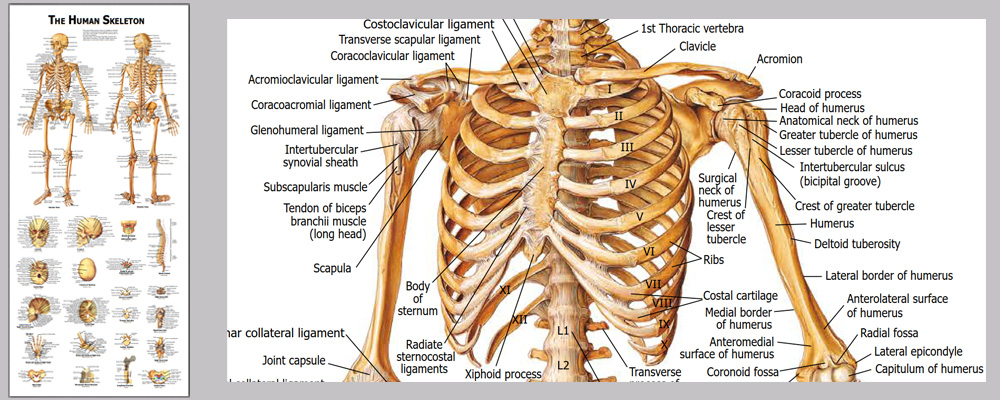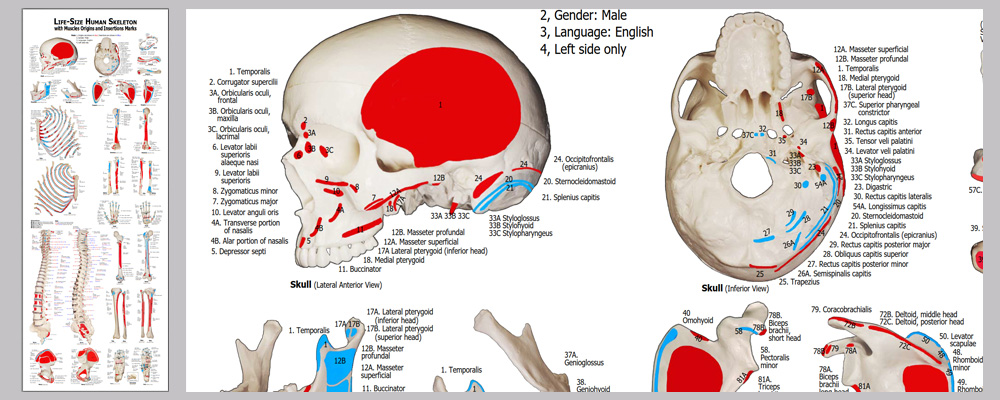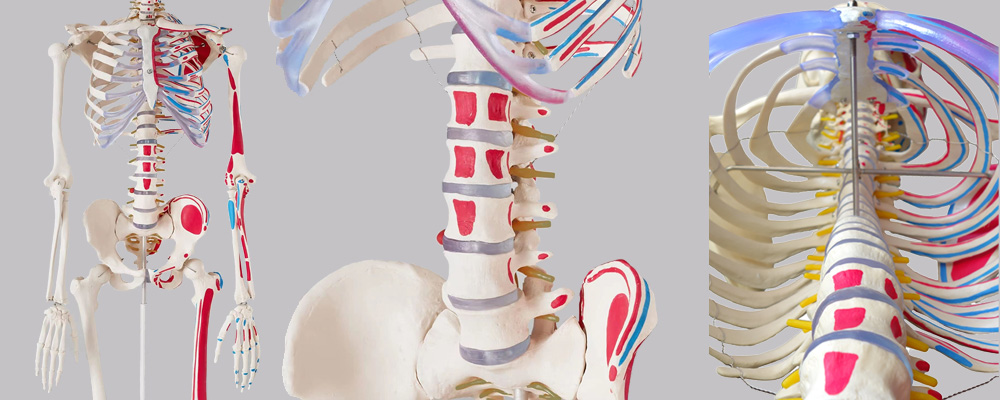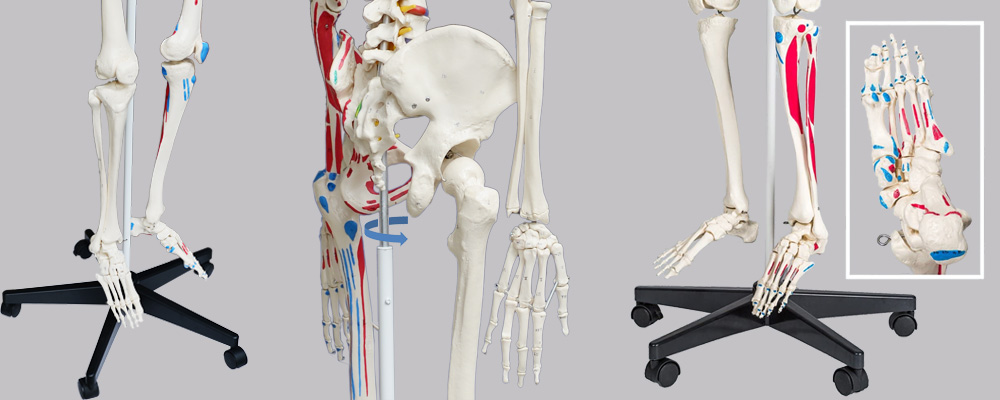human skeleton pelvis model
This life size articulated adult human skeleton model is 180cm tall & ideal for teaching / learning the basics of human anatomy. Includes a colorful Human Skeleton chart to show all the detailed structures for reference.Detailed colorful chart with over 630 accurate definitions. Durable and no reflection with matte film covered, 36 * 78cm

Detailed muscles origins and insertions with codes. Durable and no reflection with matte film covered, 100cm * 38cm

Stainless steel wires keep the ribs gaps stable.

2 of 5 casters are lockable.

With JC anatomy, you can also demonstrate the movements of the skull via the head joints, and thanks to the fully flexible spine, you can adjust the human skeleton pelvis model to place it in natural body postures. The unique combination of muscle origins and insertions, the numbered bones, flexible ligaments and flexible spine with a slipped disc between the 3rd and 4th lumbar vertebrae clearly the show medical and anatomical interest of this top model's more than 679 structures. Now available on a stable metal stand with 5 casters!
| Product name | human skeleton pelvis model |
| Place of Origin | Shenzhen China |
| Product Material | PVC, ABS, SST |
| Rib cage | A 5mm dia |
| Human skeleton model life | 16years |
| Surface treatment | Polish. Etched. Texture |
| SUPPORT 24/7 | Contact us 24 hours a day, 7 days a week |
| Size | 89 * 47 * 110 |
| Port | Shenzhen |
| PAYMENT & ORDERING | PayPal account or pay by credit card |
human skeleton pelvis model FAQs Guide Are you looking for a quick review guide about human skeleton pelvis model? An ultimate FAQs buying guide is available to help you.This guide contains all the information about all the important facts, figures, and various processes regarding human skeleton pelvis model. Let’s continue!
2.How can a human skeleton pelvis model be utilized for rehabilitation and physiotherapy purposes?
3.Can the human skeleton pelvis model be disassembled and assembled to facilitate learning and display?
4.About human skeleton pelvis model production capacity
5.Does the manufacturer of this human skeleton pelvis model provide relevant anatomy teaching materials?
6.Does the human skeleton pelvis model have movable joints that can show the range of motion of various parts of the human body?
7.Can the human skeleton pelvis model display many different body poses?
8.human skeleton pelvis model Are accompanying labels provided indicating the name and location of each bone?
9.What aspects of bone structure can be observed in this human skeleton pelvis model?
10.About human skeleton pelvis model production management system
11.Is this human skeleton pelvis model suitable for anatomy learning?
12.human skeleton pelvis model Can it be used as a teaching aid?
13.How much weight can human skeleton pelvis model hold?
1.Does this human skeleton pelvis model include all human skeletal systems?
It depends on the model in question. Some Human skeleton models may include all human skeletal systems such as the axial skeleton (skull, vertebral column, ribcage), appendicular skeleton (arms, legs, shoulder girdle, pelvic girdle), and cartilaginous skeleton (cartilaginous structures such as the nose and ears). However, others may only include certain systems or be limited to specific areas of the body. It is important to carefully read the product description or ask the manufacturer for a detailed list of what is included in the model to ensure that it meets your needs.
2.How can a human skeleton pelvis model be utilized for rehabilitation and physiotherapy purposes?
Demonstrate the right bone parts postion relationships can help doctors and patients to understanhuman skeleton model can be a valuable tool for rehabilitation and physiotherapy purposes as it can aid in teaching and demonstrating proper body mechanics, identifying and addressing musculoskeletal imbalances and dysfunctions, and monitoring progress in treatment. Here are some ways in which a human skeleton model can be utilized for rehabilitation and physiotherapy purposes: 1. Education: A human skeleton model can be used to educate patients and clients about the structure and function of the human body. This can help them understand their injuries or conditions better, and also make them more aware of how their body moves and functions. 2. Creating personalized treatment plans: With the help of a skeleton model, therapists can design personalized treatment plans for each individual patient. This can include exercises and movements targeted at specific areas of the body that need strengthening or stretching.d the right way of rehabilitation and physiotherapy.
3.Can the human skeleton pelvis model be disassembled and assembled to facilitate learning and display?
Yes, many human skeleton models are designed to be disassembled and assembled for educational purposes. The bones are typically connected by metal or plastic clips that can be easily removed and reattached, allowing for the skeleton to be taken apart and put back together. This feature makes the model useful for learning about the different bones and their connections, as well as their placement in the body. Students can learn the names and locations of each bone by taking them apart and reassembling them in the correct order. This hands-on approach can be helpful for visual learners and can make the learning process more engaging and interactive.
4.About human skeleton pelvis model production capacity
600pcs each month
5.Does the manufacturer of this human skeleton pelvis model provide relevant anatomy teaching materials?
Yes, we provide a series charts to support teaching and learning
6.Does the human skeleton pelvis model have movable joints that can show the range of motion of various parts of the human body?
Yes, the human skeleton model typically has movable joints that can show the range of motion of various parts of the human body. These joints are usually represented by different types of articulations such as ball and socket, hinge, saddle, pivot, and gliding joints, which mimic the movement of the actual joints in the human body. For example, the shoulder joint of a human skeleton model will have a ball and socket structure that allows for a wide range of motion, similar to the shoulder joint in a real human body. This joint is able to rotate 360 degrees and can also move forward, backward, and sideways. Similarly, the elbow joint in a human skeleton model will have a hinge structure that allows for flexion and extension movements, just like the elbow joint in a real human body. This enables the model to accurately demonstrate movements such as bending and straightening of the arm.
7.Can the human skeleton pelvis model display many different body poses?
The Human skeleton model can display many different body poses in order to show the movement and positioning of bones and muscles. The model can be manipulated into a range of poses such as the classical anatomical position, where the arms are down by the sides, palms facing forward, and feet shoulder-width apart. It can also be posed to demonstrate actions such as walking, running, jumping, and sitting. The flexibility of the model allows for a wide range of movements to be shown, from simple movements of individual joints to complex combinations of actions involving multiple joints. Additionally, the model can display different body poses by adjusting the positions of individual bones and joints. For example, the arms can be raised or lowered, the elbows bent or straightened, and the fingers spread or closed. The legs can be straightened or bent at the knee, and the ankles can be rotated to show different directions of movement. These adjustments allow for a variety of poses to be demonstrated, from relaxed positions to more dynamic and active positions. In summary, the Human skeleton model can display a wide variety of body poses and movements, ranging from simple to complex, to showcase the functions and interactions of the bones and muscles in the human body.
8.human skeleton pelvis model Are accompanying labels provided indicating the name and location of each bone?
The stardard model does not provide this function. The chart shipped with pro model shows the name and location of each bone
9.What aspects of bone structure can be observed in this human skeleton pelvis model?
1. Long bones: The long bones of the skeleton model, such as the femur, tibia, and humerus, have a cylindrical shape and are longer than they are wide. They also have distinct features such as a rounded head at one end and an expanded area at the other end for attachment points of muscles and ligaments. 2. Short bones: The carpals in the wrist and tarsals in the foot are examples of short bones that are generally cube-shaped and are specialized for mobility and flexibility. These bones can be seen in the skeleton model as small, compact bones. 3. Flat bones: The flat bones of the skeleton, such as the skull, sternum, and scapula, are thin and flattened, providing protection for internal organs or attachment sites for muscles. These bones can be observed in the skeleton model as flat and smooth. 4. Irregular bones: The irregular bones, such as the vertebrae and pelvis bones, have complex shapes and vary in size and structure. The spine and hip bones can be identified on the skeleton model as examples of irregular bones.
10.About human skeleton pelvis model production management system
20 years, very stable
11.Is this human skeleton pelvis model suitable for anatomy learning?
Yes, this human skeleton model is suitable for anatomy learning for several reasons. 1. Lifelike appearance: The model closely resembles the human skeleton in terms of size, shape, and detail. This makes it easier for students to visualize and understand the placement and functioning of bones in the human body. 2. Detailed labeling: The model comes with detailed labeling of all the bones and structures, helping students to learn the correct terminology and understand the location and function of each bone. 3. Removable parts: The model has removable limbs, joints, and other parts, allowing students to explore and study the underlying supportive, connective, and reproductive structures, such as ligaments, tendons, and cartilage. 4. Durable materials: The model is made of high-quality, durable materials that can withstand regular handling, making it suitable for use in classrooms, laboratories, and homes. 5. Realistic movement: The model's limbs can be moved in a way similar to human movement, making it an effective tool for demonstrating physiological processes and the range of motion of different joints. 6. Interactive learning: This model can be used in interactive learning sessions, such as small group discussions and hands-on activities, to foster a deeper understanding of the human skeleton and its functioning.
12.human skeleton pelvis model Can it be used as a teaching aid?
Yes, a human skeleton model is a commonly used teaching aid in various academic fields such as anatomy, biology, and medical education. It is an accurate and detailed representation of the human skeleton, providing a visual aid for students to understand and grasp the complexities of the skeletal system.
13.How much weight can human skeleton pelvis model hold?
The amount of weight a human skeleton model can hold depends on the materials used to make it and the structural integrity of the model. Generally, a human skeleton model made from plastic or resin can hold up to 5-10 pounds of weight. However, this weight limit may vary depending on the size and design of the model. If the model is designed to be articulated and movable, it may have a lower weight limit as the joints and connections may not be able to support heavy weights. On the other hand, a solid and non-articulated skeleton model made from sturdy materials such as metal or wood may have a higher weight limit of around 20-30 pounds.




